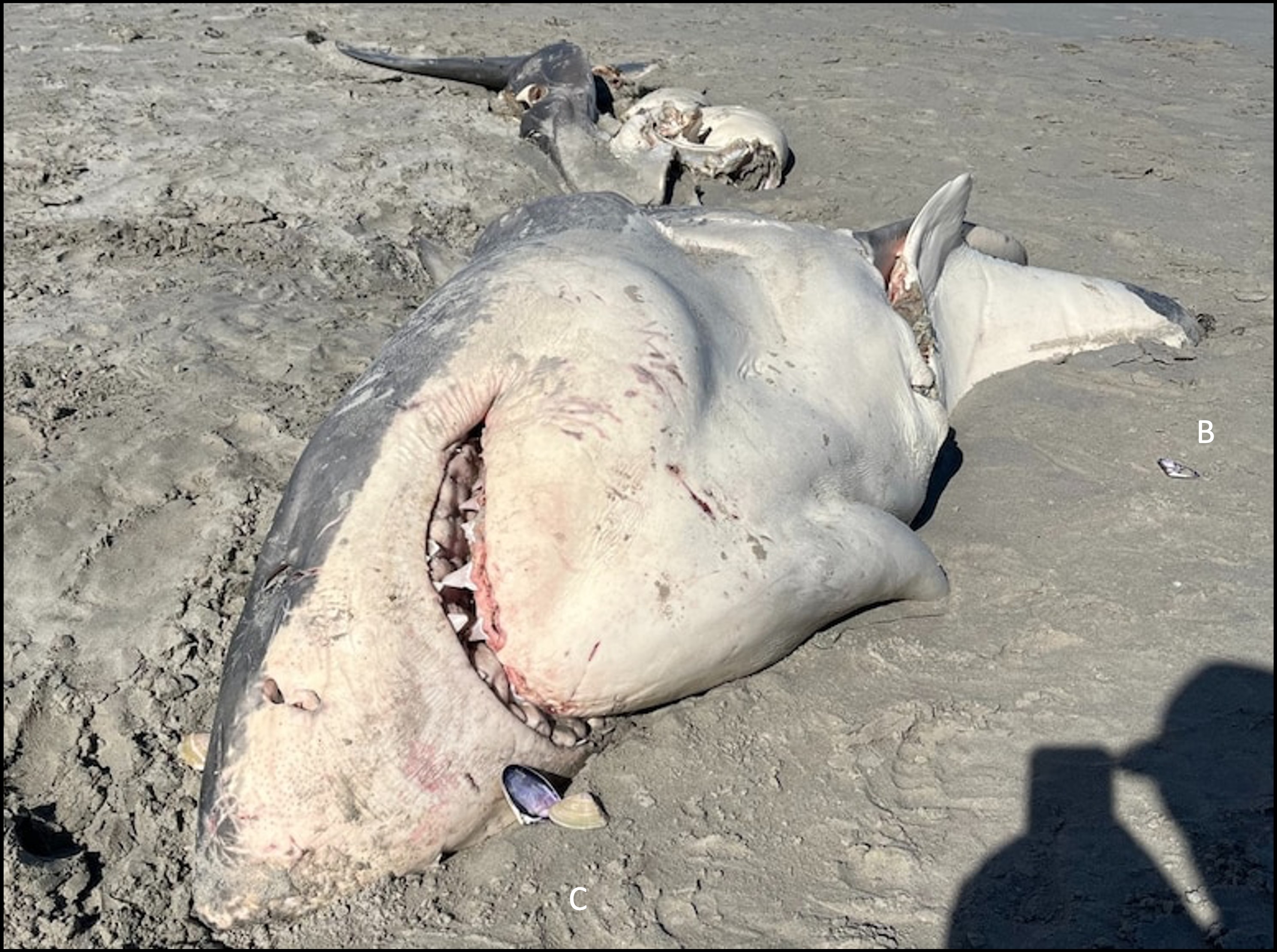In 2023, the remains of a great white shark washed up on the shore near Portland in Victoria, Australia, in 2023. It’s needless to say the body instantly caught media and scientific attention: this iconic apex predator, the source of fear and awe for so many people across the world, had been savaged by something else that had managed to tear out its liver.
ADVERTISEMENT GO AD FREE
At the time, researchers believed they knew what had managed to kill this shark, but they could not confirm it. Now, however, DNA analysis taken from the bite wound has confirmed their suspicions: orcas are hunting white sharks in Australia.

In October 2023, the body of a large great white shark was found on a beach in Portland, Australia, showing clear signs of having been attacked and killed by something large.
Image credit: Ben Johnson, Portland Bait and Tackle
Orcas, or killer whales (Orcinus orca), have been observed preying on various species of shark over the last few years, and white sharks have definitely been on the menu. For instance, a pair of orca in South Africa went on a veritable shark hunting spree in 2022 and 2023, becoming famous for their new snacking habits. These rare predations have even been caught on camera, reveal just how orcas work together to take down their prey.
As such, when the remains of the large white shark washed up on the beach near Portland in 2023, it offered a unique opportunity to analyze the distinct bite wounds and to investigate who the killer was.
“The liver, digestive and reproductive organs were missing, and there were four distinctive bite wounds, one of which was characteristic of liver extraction by killer whale, similar to what has been observed in South Africa,” lead author Isabella Reeves, a PhD candidate with Flinders University’s Southern Shark Ecology Group and the West Australian Cetacean Research Centre (CETREC), said in a statement.
“Swabs were taken from bite wounds on the white shark and sequenced for remnant genetic material from the shark’s predator. We were able to confirm the presence of killer whale DNA in the primary bite area, while the other three wounds revealed DNA from scavenging broadnose sevengill sharks.”
The results offer compelling evidence that orcas are hunting white sharks in Australian waters and appear to be targeting their livers.
ADVERTISEMENT GO AD FREE
“This suggests that such predation events may be more widespread and prevalent across the globe than previously believed,” Reeves added.
Reeves and colleagues used wildlife forensic techniques to confirm that the animals were responsible for excising and eating the shark’s liver. Two days before the shark’s body was found on the beach, civilian bystanders had seen several orcas, including locally known individuals called “Bent Tip and “Ripple”, catching something large in Bridgewater Bay.

Wildlife forensics helped the researchers identify orcas as the white shark’s killer.
Image credit: Emma Luck
This is not the first time orcas have hunted sharks in Australia. They have previously been recorded preying on blue sharks (Prionace glauca), porbeagles (Lamna nasus), shortfin makos (Isurus oxyrinchus), ground sharks that were likely school sharks (Galeorhinus galeus), and tiger sharks (Galeocerdo cuvier). However, the targeted consumption of white shark livers was, until now, unknown in these waters, despite it being recorded elsewhere.
Back in 2015, orcas were seen interacting with a white shark at the Neptune Island Group Marine Park in South Australia, but while an oil slick – which is usually a sign of a successful kill – was seen, a carcass was never recovered.
ADVERTISEMENT GO AD FREE
In other places like South Africa and California, the predation efforts by orcas on white sharks have led to disruptions in local shark populations. “However direct observations of these interactions remain rare and their frequency is poorly understood,” explained study author Dr Alison Towner, a Rhodes University (South Africa) marine biologist.
“We don’t know how frequently these events occurred in Australian waters and therefore how significant these findings are,” said senior author Associate Professor Adam Miller, who is a senior ecologist with Cesar Australia.
“Evidence suggests that the white sharks being displaced or directly killed as a result of the killer whale predation in South Africa has led to cascading shifts in the wider marine ecosystem.”
Miller also explained that white sharks are key regulators in marine ecosystems, influencing their structure and function. So, it is increasingly crucial that we protect these top predators.
ADVERTISEMENT GO AD FREE
“Therefore, it is important that we keep a tab on these types of interactions in Australian waters where possible,” Miller added.
The study of this shark’s body also brought to light another phenomenon associated with these orcas’ hunts: namely, the opportunities it provides other species.
“This study also provides DNA evidence that scavenging is facilitated by killer whales’ tissue selection, whereby the liver and internal organs are consumed, but much of the carcass remains as a nutrient source benefiting local ecosystems,” study author and Flinders University research fellow Dr Lauren Meyer added.
The study is published in Ecology and Evolution.
Source Link: Orcas Confirmed Hunting Australian White Shark For Its Liver For First Time